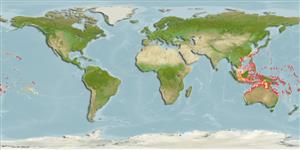>
Eupercaria/misc (Various families in series Eupercaria) >
Scaridae (Parrotfishes) > Scarinae
Etymology: Chlorurus: Greek, chloros = green + Greek oura = tail (Ref. 45335).
More on author: Bleeker.
Environment: milieu / climate zone / rango de profundidad / distribution range
Ecología
marino asociado a arrecife; rango de profundidad 0 - 50 m (Ref. 90102), usually 1 - 15 m (Ref. 89972). Tropical; 31°N - 35°S, 105°E - 124°W
Pacific Ocean: Bali and the Philippines to the Line and Pitcairn islands, north to the Ryukyu Islands, south to Rottnest Island, Lord Howe Island and Rapa Island (Ref. 37816). The species complex comprise of Chlorurus gibbus in the Red Sea, Chlorurus strongylocephalus in the Indian Ocean and Chlorurus microrhinos in the west-central Pacific.
Tamaño / Peso / Age
Madurez: Lm ? range ? - ? cm
Max length : 70.0 cm TL macho / no sexado; (Ref. 2334); common length : 49.0 cm SL macho / no sexado; (Ref. 37816); common length :40 cm SL (female); peso máximo publicado: 5.4 kg (Ref. 37816)
Short description
Claves de identificación | Morfología | Morfometría
Espinas dorsales (total) : 9; Radios blandos dorsales (total) : 10; Espinas anales: 3; Radios blandos anales: 9. Juveniles below about 8 cm are black with several horizontal white streaks. Larger ones up to about 20 cm uniformly dark, greenish brown, slowly becoming blue with age. Blue streak and patch extending behind the corner of the mouth of large males often quite brilliant. Uniformly yellowish-tan individuals rare. Caudal fin lunate in large terminal males. Scale rows on cheek 3. Median predorsal scales 3-4 (Ref. 37816). Males develop large hump on head and appear blunt-headed (Ref. 48636).
Body shape (shape guide): fusiform / normal; Cross section: oval.
Occurs in lagoon and seaward reefs. Juveniles generally solitary; large adults often school together. Feeds on benthic algae (Ref. 89972). Minimum depth reported taken from Ref. 128797.
Life cycle and mating behavior
Madurez | Reproducción | Puesta | Huevos | Fecundidad | Larva
Oviparous, distinct pairing during breeding (Ref. 205).
Parenti, P. and J.E. Randall, 2000. An annotated checklist of the species of the labroid fish families Labridae and Scaridae. Ichthyol. Bull. J.L.B. Smith Inst. Ichthyol. (68):1-97. (Ref. 35918)
IUCN Red List Status (Ref. 130435: Version 2025-1)
Threat to humans
Reports of ciguatera poisoning (Ref. 4690)
Human uses
Pesquerías: comercial
Herramientas
Special reports
Download XML
Fuentes de Internet
Estimates based on models
Preferred temperature (Referencia
123201): 24.8 - 29.3, mean 28.4 °C (based on 1923 cells).
Phylogenetic diversity index (Referencia
82804): PD
50 = 0.5000 [Uniqueness, from 0.5 = low to 2.0 = high].
Bayesian length-weight: a=0.01445 (0.01200 - 0.01742), b=3.03 (2.98 - 3.08), in cm total length, based on LWR estimates for this species (Ref.
93245).
Resiliencia (Referencia
120179): Bajo, población duplicada en un tiempo mínimo de 4.5-14 años (tmax=14; k=0.22).
Fishing Vulnerability (Ref.
59153): Moderate to high vulnerability (48 of 100).
🛈
Nutrients (Ref.
124155): Calcium = 22.1 [8.8, 72.4] mg/100g; Iron = 0.51 [0.20, 1.29] mg/100g; Protein = 18.6 [16.5, 20.4] %; Omega3 = 0.0867 [, ] g/100g; Selenium = 44.6 [14.4, 131.5] μg/100g; VitaminA = 39.7 [11.9, 127.6] μg/100g; Zinc = 1.87 [0.84, 3.34] mg/100g (wet weight);
